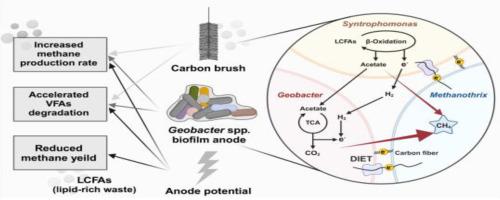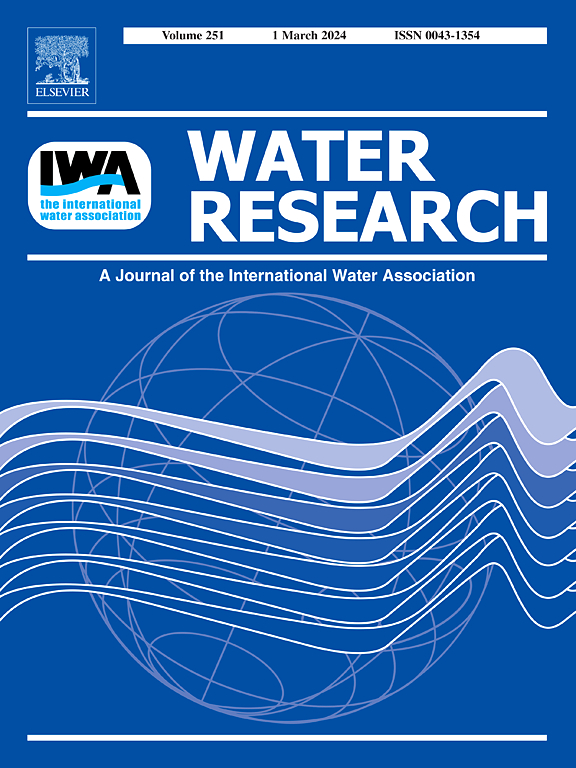Understanding the Microbial Processes on Carbon Brushes that Accelerate Methanogenesis of Long-Chain Fatty Acids in Anaerobic Digestion
IF 11.4
1区 环境科学与生态学
Q1 ENGINEERING, ENVIRONMENTAL
引用次数: 0
Abstract
Lipids offer high energy recovery potential during anaerobic digestion (AD), but their hydrolysis generates long-chain fatty acids (LCFAs), which are difficult to biodegrade. The introduction of microbial electrolysis cells has been widely recognized as a promising strategy to enhance AD. However, it is still under debate whether the electrical circuit needs to be connected, as certain electrodes with large specific surface areas have been reported to enhance direct interspecies electron transfer (DIET) without requiring an external power supply. Here we confirmed that the carbon brush anode pre-acclimated with electroactive bacteria (EAB) was able to accelerate LCFA methanation. Although the applied potential achieved a rapid methane production, the coupling of homoacetogenesis and electrogenesis consumed part of the bioelectrohydrogen, reducing the maximum methane production rate by 5–13%. In the AD system with only carbon brushes added, the dominant methanogens shifted from Methanosarcina in solution to Methanothrix on brushes. Pre-enriching EAB further established a composite mechanism, with DIET driven by Syntrophomonas, Geobacter and Methanothrix as the primary pathway, and interspecies hydrogen transfer mediated by Methanospirillum as a complementary process, collectively optimizing LCFA methanation. Genetic regulation underlying microbial tolerance to high LCFA concentrations was then elucidated, underscoring the critical role of combining immobilized electrodes and pre-acclimated EAB in adapting to LCFA stress and improving lipid-rich wastewater treatment.

了解厌氧消化中加速长链脂肪酸产甲烷的碳刷微生物过程
脂质在厌氧消化(AD)过程中具有很高的能量回收潜力,但其水解产生的长链脂肪酸(LCFAs)难以生物降解。引入微生物电解细胞已被广泛认为是一种有前途的策略,以提高AD。然而,是否需要连接电路仍存在争议,因为据报道,某些具有大比表面积的电极可以增强直接种间电子转移(DIET),而无需外部电源。本研究证实,经电活性菌(EAB)驯化的碳刷阳极能够加速LCFA甲烷化。虽然应用电位实现了快速产甲烷,但均质产氢和电生的耦合消耗了部分生物电氢,使最大产甲烷率降低了5-13%。在仅添加碳刷的AD体系中,优势产甲烷菌由溶液中的甲烷菌(Methanosarcina)转变为刷上的甲烷菌(Methanothrix)。预富集EAB进一步建立了以Syntrophomonas、Geobacter和Methanothrix驱动的DIET为主要途径,Methanospirillum介导的种间氢转移为补充过程的复合机制,共同优化了LCFA甲烷化。然后阐明了微生物对高浓度LCFA耐受性的遗传调控,强调了将固定化电极和预驯化的EAB结合在适应LCFA胁迫和改善富脂废水处理方面的关键作用。
本文章由计算机程序翻译,如有差异,请以英文原文为准。
求助全文
约1分钟内获得全文
求助全文
来源期刊

Water Research
环境科学-工程:环境
CiteScore
20.80
自引率
9.40%
发文量
1307
审稿时长
38 days
期刊介绍:
Water Research, along with its open access companion journal Water Research X, serves as a platform for publishing original research papers covering various aspects of the science and technology related to the anthropogenic water cycle, water quality, and its management worldwide. The audience targeted by the journal comprises biologists, chemical engineers, chemists, civil engineers, environmental engineers, limnologists, and microbiologists. The scope of the journal include:
•Treatment processes for water and wastewaters (municipal, agricultural, industrial, and on-site treatment), including resource recovery and residuals management;
•Urban hydrology including sewer systems, stormwater management, and green infrastructure;
•Drinking water treatment and distribution;
•Potable and non-potable water reuse;
•Sanitation, public health, and risk assessment;
•Anaerobic digestion, solid and hazardous waste management, including source characterization and the effects and control of leachates and gaseous emissions;
•Contaminants (chemical, microbial, anthropogenic particles such as nanoparticles or microplastics) and related water quality sensing, monitoring, fate, and assessment;
•Anthropogenic impacts on inland, tidal, coastal and urban waters, focusing on surface and ground waters, and point and non-point sources of pollution;
•Environmental restoration, linked to surface water, groundwater and groundwater remediation;
•Analysis of the interfaces between sediments and water, and between water and atmosphere, focusing specifically on anthropogenic impacts;
•Mathematical modelling, systems analysis, machine learning, and beneficial use of big data related to the anthropogenic water cycle;
•Socio-economic, policy, and regulations studies.
 求助内容:
求助内容: 应助结果提醒方式:
应助结果提醒方式:


